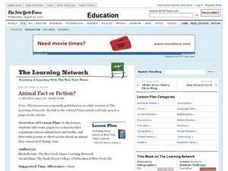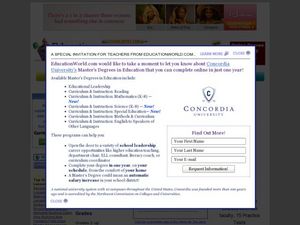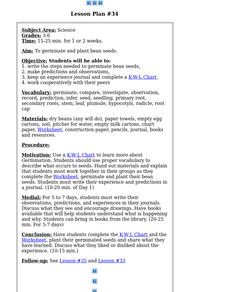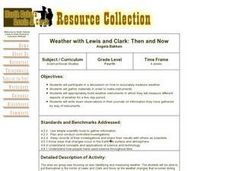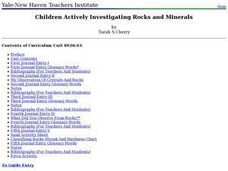Curated OER
What's Crackin' Under New Zealand
Students construct a model of the Earth using clay and oranges. In this earth science instructional activity, students explain the causes of earthquakes and volcanic activity. They write their findings in their science journal.
Curated OER
Do It Yourself: Energy Transfer Lesson Plan
Fifth graders discuss the different types of energy and experiment with tesla coil to show the three types of energy transfer. They write conclusions in their science journal.
Curated OER
All's Well for Stem Cells
By exploring the latest research on cell and tissue renewal your young scientists can understand the various internal body parts and systems examined in these studies.
Curated OER
Animal Fact or Fiction?
Read and discuss the article "Welcome to Cicadaville (Enter at Your Own Risk)" to gain a better understanding around the confusion regarding cicadas and locust swarms. In groups your young analysts research statements about animals to...
Curated OER
Butterflies, Butterflies, Butterflies
Transform your class into a butterfly museum! Research different types of butterflies, their habitat, and life cycle. Interactive components such as PowerPoint presentations, Claymation movies, and webpages add pizzaz to the museum...
Curated OER
Baby Elephant Orphans Get New Home, Families
Students react to a series of statements about elephants, then read a news article about how workers at an elephant orphanage are working to return the animals to the wild. In the animal studies and current events lesson, the teacher...
NASA
Biology Training Module
Are you a koalafied biologist? The lesson begins with research about human survival and our ecosystem. Then, an online training module simulates the effects of changes to the plants and animals in an ecosystem. Finally, scholars research...
Curated OER
Creature Seekers
Does it actually exist? Consider the sighting of a giant squid, much like the one that appears in 20,000 Leagues Under the Sea. Middle and high schoolers read the article One Legend Found, Many Still to Go, and research other mysterious...
Curated OER
Keying Rocks
Young geologists learn how to use an identification key in order to classify rocks. The key is designed to help them classify rocks into three types: ignesous, metamorphic, and sediimentary. After an initial teacher-led demonstration,...
Curated OER
Pharaoh Mountain Hike: Investigating Adirondack Life Zones
Students hike a local mountain and examine its life zones. They measure various components at each zone and collect leaf litter at the sites. At the mountain top, students make descriptive observations and complete a handout about the...
NASA
Decomposers Get Energy From Dead Things
When life gives you mold, make penicillin. Scholars design an inquiry experiment to determine what causes rotting and mold growth. It also covers decomposers and the important role they play for other living things.
NASA
Producers Make Their Own Food
During an inquiry-based lesson plan, scholars decide which variable to test and then design an experiment to determine the needs of producers. After two weeks, they complete a full analysis and research paper.
National Security Agency
Equations and Expressions
Learners demonstrate their knowledge pictorially, concretely, and abstractly in this unit meant to last three hours over three days. Using hands-on activities, manipulatives, real-world applications, and problem...
Curated OER
The Water Cycle (Evaporation, Condensation, Precipitation)
The 3 steps of the water cycle, evaporation, condensation, and precipitation, are the focus of this lesson. After a neat demonstration of rain using hot water, a pie tin, and ice cubes, young scientists observe and discuss the elements...
Curated OER
The Times and Life During the California Gold Rush
Fourth graders read about the era in their history books, write in their journals revolving around the Gold Rush, making crafts such as newspapers, and also play the part of the Forty-niners.
Curated OER
Global Environmental Issues: Air and Water Pollution
Thinking about designing a project for your social studies or environmental science classes? Use an overview of a project that prompts class groups to research an environmental issue.
Scholastic
Hillary Conquers Everest
If a field trip to the summit of Mount Everest isn't in your school budget, make the trek virtually! An interactive instructional activity allows class members to follow Sir Edmund Hillary and Tenzing Norgay's trail up the mountain, and...
Curated OER
The Kidlink Day Project
Students create journal entries on-line as part of a "Kidlink Day" activity. Entries are compared and evaluated by their peers. The writing process is practiced in this lesson.
Curated OER
Germinate Bean Seeds
Students write the steps needed to germinate bean seeds, make predictions and observations and keep an experience journal and complete a chart.
Curated OER
Growth of a Bean Documented by Child and Camera
Third graders photograph the growth of a bean plant and keep a daily written journal of observations. They drew, graphed and took notes on the plant growth which they compared to the photographic journal.
Curated OER
Animals of Africa
Students identify animals indigenous to Africa, then create an imaginary animal using various materials they have at home. They write about their animal and include its name, characteristics, and describe how it defends itself.
Curated OER
Weather with Lewis and Clark: Then and Now
Fourth graders observe and write descriptions of the weather in a journal for one week. They research the daily journals of Lewis and Clark, compare the weather words used to their own personal journals, and discuss the need to...
Curated OER
Children Actively Investigating Rocks and Minerals
Young scholars follow directions to set up their own record keeping journal. As a class, they are introduced to the characteristics of crystals and identify three types of crystals they see in their everyday lives. They examine...
Curated OER
Interview with Meriwether Lewis
Learners ask questions and prepare responses to Meriwether Lewis and his expedition. In this journal instructional activity students present their questions to the class.



